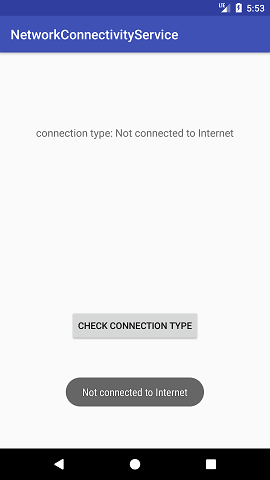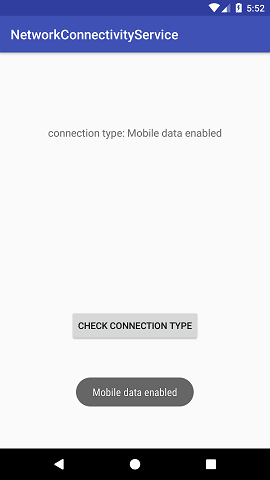TheDeveloperBlog.com
C-Sharp | Java | Python | Swift | GO | WPF | Ruby | Scala | F# | JavaScript | SQL | PHP | Angular | HTML
Android Network Connectivity Services
Android Network Connectivity Services with examples of Activity and Intent, Fragments, Menu, Service, alarm manager, storage, sqlite, xml, json, multimedia, speech, web service, telephony, animation and graphics
Android Network Connectivity ServicesAndroid network connectivity services allow us to check the network connectivity information of the device. It is very important to check the internet connection of the device while performing the task which is based on internet service such as fetching data from the server (internet) or writing data to the server. Using Android Network Connectivity Services we can also determine the types of a network of android device. It may be of types TYPE_WIFI (wifi), TYPE_MOBILE (mobile), TYPE_BLUETOOTH (Bluetooth), etc. Android Network Connectivity Service Example
Let's create a simple example to check the network connectivity of the device as well as its type. To access the network connectivity of a device, we need to provide the network access permission in AndroidMenifest.xml file. <uses-permission android:name="android.permission.ACCESS_NETWORK_STATE" /> In the activity_main.xml file of layout add the following code. For accessing the network state of a device, there is no requirement of the layout file. Here, we are using the activity_main.xml file only for storing the state of network type. activity_main.xml
<?xml version="1.0" encoding="utf-8"?>
<android.support.constraint.ConstraintLayout xmlns:android="http://schemas.android.com/apk/res/android"
xmlns:app="http://schemas.android.com/apk/res-auto"
xmlns:tools="http://schemas.android.com/tools"
android:layout_width="match_parent"
android:layout_height="match_parent"
tools:context="example.TheDeveloperBlog.com.networkconnectivityservice.MainActivity">
<TextView
android:id="@+id/textView"
android:layout_width="wrap_content"
android:layout_height="wrap_content"
android:textSize="16dp"
android:layout_marginBottom="8dp"
android:layout_marginEnd="8dp"
android:layout_marginStart="8dp"
android:layout_marginTop="8dp"
android:contentDescription="networkstate"
android:text="Network state ?"
app:layout_constraintBottom_toBottomOf="parent"
app:layout_constraintEnd_toEndOf="parent"
app:layout_constraintRight_toRightOf="parent"
app:layout_constraintStart_toStartOf="parent"
app:layout_constraintTop_toTopOf="parent"
app:layout_constraintVertical_bias="0.183" />
<Button
android:id="@+id/button"
android:layout_width="wrap_content"
android:layout_height="wrap_content"
android:layout_marginEnd="8dp"
android:layout_marginStart="8dp"
android:text="Check Connection Type"
android:layout_marginTop="392dp"
app:layout_constraintEnd_toEndOf="parent"
app:layout_constraintStart_toStartOf="parent"
app:layout_constraintTop_toTopOf="parent" />
</android.support.constraint.ConstraintLayout>
Create a java class named as NetworkState.java. This class contains a getConnectivityStatus() method which returns the constant integer value on the basis of current network connection. The code context.getSystemService(Context.CONNECTIVITY_SERVICE) is used to return the instance of the ConnectivityManager class which access the network properties. NetworkState.java
package example.TheDeveloperBlog.com.networkconnectivityservice;
import android.content.Context;
import android.net.ConnectivityManager;
import android.net.NetworkInfo;
public class NetworkState {
public static int TYPE_NOT_CONNECTED = 0;
public static int TYPE_WIFI = 1;
public static int TYPE_MOBILE = 2;
public static int getConnectivityStatus(Context context) {
ConnectivityManager cm = (ConnectivityManager) context.getSystemService(Context.CONNECTIVITY_SERVICE);
NetworkInfo activeNetwork = cm.getActiveNetworkInfo();
if (null != activeNetwork) {
if(activeNetwork.getType() == ConnectivityManager.TYPE_WIFI)
return TYPE_WIFI;
if(activeNetwork.getType() == ConnectivityManager.TYPE_MOBILE)
return TYPE_MOBILE;
}
return TYPE_NOT_CONNECTED;
}
public static String getConnectivityStatusString(Context context) {
int conn = NetworkState.getConnectivityStatus(context);
String status = null;
if (conn == NetworkState.TYPE_WIFI) {
status = "Wifi enabled";
} else if (conn == NetworkState.TYPE_MOBILE) {
status = "Mobile data enabled";
} else if (conn == NetworkState.TYPE_NOT_CONNECTED) {
status = "Not connected to Internet";
}
return status;
}
}
Create a receiver class named as NetworkReceiver.java and extends the BroadcastReciever class. This class handles the changes occur in the network state of a device. The onReceive() method of BroadcastReciever class called when the network state of device changes. NetworkReceiver.java
package example.TheDeveloperBlog.com.networkconnectivityservice;
import android.content.BroadcastReceiver;
import android.content.Context;
import android.content.Intent;
import android.widget.Toast;
public class NetworkReceiver extends BroadcastReceiver {
static String status =null;
@Override
public void onReceive(Context context, Intent intent) {
status = NetworkState.getConnectivityStatusString(context);
Toast.makeText(context, status, Toast.LENGTH_LONG).show();
if(status == "Wifi enabled"){
//your code when wifi enable
}
else if(status=="Mobile data enabled"){
//your code when TYPE_MOBILE network enable
}
else if(status=="Not connected to Internet"){
//your code when no network connected
}
}
}
In the MainActivity.java class, we are displaying the network state of a device in TextView by clicking the Button. MainActivity.java
package example.TheDeveloperBlog.com.networkconnectivityservice;
import android.support.v7.app.AppCompatActivity;
import android.os.Bundle;
import android.view.View;
import android.widget.Button;
import android.widget.TextView;
import android.widget.Toast;
public class MainActivity extends AppCompatActivity {
Button button;
TextView textView;
@Override
protected void onCreate(Bundle savedInstanceState) {
super.onCreate(savedInstanceState);
setContentView(R.layout.activity_main);
button = findViewById(R.id.button);
textView = findViewById(R.id.textView);
button.setOnClickListener(new View.OnClickListener() {
@Override
public void onClick(View v) {
NetworkReceiver receiver = new NetworkReceiver() ;
String networkStatus = receiver.status;
textView.setText("connection type: "+networkStatus);
Toast.makeText(getApplicationContext(), networkStatus, Toast.LENGTH_LONG).show();
}
});
}
}
In the AndroidMenifest.xml file, add the network access permission and receiver class that handles the changes occur in BroadcastReceiver class. AndroidMenifest.xml
<?xml version="1.0" encoding="utf-8"?>
<manifest xmlns:android="http://schemas.android.com/apk/res/android"
package="example.TheDeveloperBlog.com.networkconnectivityservice">
<uses-permission android:name="android.permission.ACCESS_NETWORK_STATE"/>
<uses-permission android:name="android.permission.INTERNET"/>
<application
android:allowBackup="true"
android:icon="@mipmap/ic_launcher"
android:label="@string/app_name"
android:roundIcon="@mipmap/ic_launcher_round"
android:supportsRtl="true"
android:theme="@style/AppTheme">
<activity android:name=".MainActivity">
<intent-filter>
<action android:name="android.intent.action.MAIN" />
<category android:name="android.intent.category.LAUNCHER" />
</intent-filter>
</activity>
<receiver
android:name=".NetworkReceiver"
android:enabled="true">
<intent-filter>
<action android:name="android.net.conn.CONNECTIVITY_CHANGE" />
<action android:name="android.net.wifi.WIFI_STATE_CHANGED" />
</intent-filter>
</receiver>
</application>
</manifest>
Output 

Next TopicFirebase Authentication - Google Login
|
Related Links:
- Android MediaRecorder example
- Learn Android Tutorial | Android Studio Tutorial
- Android Custom RadioButton
- Android AlertDialog Example
- Android Spinner Example
- Android Versions
- Android Watch
- Android Seekbar example
- Android DatePicker Example
- Android TimePicker Example
- Android Sqlite Tutorial
- Android SQLite Example with Spinner
- Android XML Parsing using SAX Parser
- Android RSS Feed Reader
- Android Linkify Example
- Android AutoCompleteTextView Example
- Android ListView Example
- Android AlarmManager
- Android Google Map Search Location using Geocodr
- Android Emulator
- Android Auto
- Android File Transfer
- Android Hide Title Bar Example
- Android TextToSpeech Tutorial
- Android TextToSpeech Example
- Android Volley Library - Registration, Log-in, and Log-out
- Android ScrollView Horizontal
- Android Network Connectivity Services
- Android Messages
- Android Oreo
- Android TV
- Android Screenshot
- Android Custom CheckBox
- Android RadioButton
- Android Dynamic RadioButton
- Android StartActivityForResult Example
- Android Share App Data
- Android Fragments
- Android Simple Graphics Example
- Android Animation Example
- Android Image Switcher
- Android Image Slider
- Android Quiz | Android Online Test
- Android Option Menu Example
- Android Context Menu Example
- Android Popup Menu Example
- Android Web Service | Android Restful Web Service
- Android Google Map
- Android Google Map displaying Current Location
- Android Service Tutorial
- Android External Storage Example - TheDeveloperBlog.com
- Adding Android Interstitial Ads
- Android QR Code / Bar Code Scanner
- Android Custom ListView
- Android RatingBar Example
- Android WebView Example
- Android Preferences Example
- Android Internal Storage Example - TheDeveloperBlog.com
- Android Analog Clock and Android Digital Clock Example
- Android ProgressBar Example
- Android ScrollView Vertical
- Android XML Parsing using DOM Parser
- Android XMLPullParser Tutorial
- Android JSON Parsing Tutorial
- Android ViewStub
- Android Intro Slider Example
- Android RecyclerView List Example
- Android Swipe to Delete RecyclerView items with UNDU
- Android Telephony Manager Tutorial
- Android Call State Example
- Android Call State BroadCastReceiver Example
- Android Firebase Authentication - Google Login
- Android Notification
- Android TabLayout
- Android TabLayout with FrameLayout
- Android SearchView
- Android SearchView on Toolbar
- Android Caller talker example
- Integrating Google Sign-In in Android App
- Integrating LinkedIn API in Android App
- Integrating Twitter API in Android App
- Android Device Manager
- Android Studio
- Android Interview Questions (2021)
- Android EditText with TextWatcher
- Android Activity Lifecycle
- Android Screen Orientation Example
- Android Intent Example
- Android Explicit Intent Example
- Android Bluetooth Tutorial
- Android bluetooth list paired devices example
- Android Wifi Example
- Android Camera Tutorial
- Android Sensor Tutorial
- Android Custom Toast Example
- Android ToggleButton Example
- Android Checkbox Example | Food Ordering Example
- What is android
- History of Android
- Android Architecture | Android Software Stack
- Android Core Building Blocks | Fundamental Components
- Android Widgets Tutorial
- Android Button Example
- Android Toast Example
- Adding Android Google Admob
- Adding Android Banner Ads

